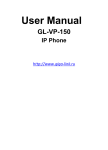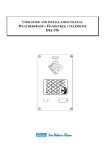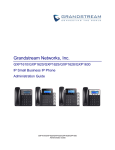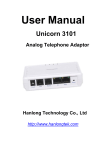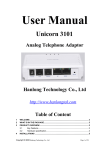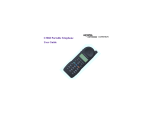Download HD2000 IP Phone User Manual
Transcript
HD2000 IP Phone
User Manual
http://www.diamondtelecom.eu
Table of Content
1. WELCOME........................................................................................................................ 4
2. WHAT IS IN THE PACKAGE............................................................................................. 4
3. Key Features..................................................................................................................... 5
4. Hardware specification.................................................................................................... 6
5. INSTALLATIONS............................................................................................................... 6
5.1. Power and LAN connection ................................................................................ 6
5.2. Walls mount installation: ..................................................................................... 8
6. Get Familiar with the buttons ....................................................................................... 10
7. BASIC OPERATIONS ..................................................................................................... 12
7.1. Get Familiar with Voice ..................................................................................... 12
7.2. Make a Phone call ............................................................................................ 13
7.2.1. Completing Calls............................................................................... 13
7.2.2. Quick IP Call Mode ........................................................................... 14
7.3. ANSWERING PHONE CALLS ............................................................................14
7.3.1. Receiving Calls ...................................................................................14
7.4. PHONE FUNCTIONS DURING A PHONE CALL................................................15
7.4.1. Call Hold ..............................................................................................15
7.4.2. Call Waiting and Call Flashing .............................................................15
7.4.3. Call Transfer.........................................................................................15
7.4.3.1 Blind Transfer........................................................................15
7.4.3.2 Attended Transfer .................................................................15
7.4.4. Conference Call ...................................................................................15
7.4.5. Mute incoming calls ..............................................................................16
7.4.6. Voice Messages (Message Waiting Indicator)......................................16
7.5. CALL FEATURES.................................................................................................17
7.5.1. Call Features Tables ............................................................................17
8. CONFIGURATION GUIDE...................................................................................................18
8.1. Configuring HD2000IP using Web Browser..........................................................18
8.1.1. Accessing the Web Configuration.........................................................18
8.1.2. User Programming and Configuration .................................................19
8.1.3. Passwords ...........................................................................................19
8.1.4. Configuration Options and Explanations .............................................20
8.1.4.1 Device Status.........................................................................20
8.1.4.2 Basic Options.........................................................................21
2
8.1.4.3 Account Options ....................................................................25
8.1.4.4 Super Options........................................................................34
8.1.5. Saving the Configuration Changes.......................................................38
8.1.6. Rebooting the HD2000IP......................................................................38
8.1.7. Configuration through a Central Server................................................38
9. SOFTWARE UPGRADE......................................................................................................41
10. RESTORE TO FACTORY DEFAULT SETTINGS ............................................................42
3
1. WELCOME
The IP PHONE HD2000IP is an internet telephone set that features superb audio quality, rich
functionalities, high level of integration, and compactness. By converting analog voice for
transmission over the internet, the IP Phone HD2000IP allows users with broadband internet
connections to make calls to and from anywhere in the world. The IP PHONE HD2000IP is fully
compatible with SIP industry standard and can interoperate with many other SIP compliant
devices and software on the market.
2. WHAT IS IN THE PACKAGE
The HD2000IP package contains:
One HD2000IP VoIP Phone
One power supply (option)
User manual
1 thin screw, 2 bigger screws, 1 foam.
4
3. Key Features
- Support SIP 2.0 (RFC 3261), TCP/UDP/IP, RTP/RTCP, HTTP, ICMP, ARP/RARP, DNS,
DHCP, NTP, PPPoE, STUN, UPNP,TFTP, etc.
- Powerful Digital Signal Processing (DSP) technology to ensure superior audio quality
- Support various codecs including G.711 (PCM a-law and u-law), G.723.1 , G.729A, G.726.
- Support standard encryption and authentication (DIGEST using MD5, MD5-sess)
- Support for Layer 2 (802.1Q VLAN, 802.1p) and Layer 3 QoS (ToS, DiffServ, MPLS)
- Support Silence Suppression, VAD (Voice Activity Detection), CNG (Comfort
Noise Generation), Acoustic Echo Cancellation (AEC) with Acoustic Gain Control(AGC) for
speakerphone mode.
- Support automated provisioning for mass deployment ,RTP and TLS (pending)for security
protection
- Support automated NAT traversal without manual manipulation of firewall/NAT
- Support Hold, Transfer, Forward, 3-way Conference, in-band and out-of-band DTMF, Call
Waiting, Call Log, Off-hook Auto Dial, Auto Answer, Downloadable Ringtones, SMS,Direct IP
Call, Intercom, Paging, Pick up.
- Support syslog, full duplex hands-free speakerphone with advanced acoustic echo cancellation,
redial, volume control, voice mail with indicator, downloadable ring tones.
- Provide easy configuration through manual operation (phone keypad), Web
interface or automated centralized configuration file via TFTP or HTTP
- Support 6 dedicated function keys: Mute, 3 level volume key, Flash (Hold), Message,
Conference, Redial.
- Support 3 levels ringer volume ( high/middle/off for HD2000IP with keypad, high/middle/low
for HD2000IP urgence)
5
4. Hardware specification
Model
LAN interface
Power supply (optional)
Dimension
Weight
Temperature
Humidity
HD2000IP
1x RJ45 100Base-T(POE supported)
Input: 100-240VAC 50-60 Hz
Output: +5VDC, 1200mA
CE/FCC/UL certification
215 x 165 x 70 mm (L x W x H)
0.9kg
40 – 130 F
5 – 45 C
10 - 90%
5. INSTALLATION
5.1. Power and LAN connection
Following are the steps to install a HD2000IP:
- Connect Ethernet cable from back of the phone (LAN Port) to a PoE port of switch or router.
- If you don’t have PoE switch or router, please use power adapter (optional) into back of the
phone and connect it to a power outlet.
6
Power Jack
LAN
Handset Jack
5V DC power port
10/100Mbps RJ45 port for LAN
RJ9 port connect to handset
SAFETY COMPLIANCES
The HD2000IP phone complies with FCC/CE and various safety standards. The HD2000IP
power adaptor (optional) is compliant with these standards. Only use the HD2000IP power
adaptor provided by Depaepe. The manufacturer’s warranty does not cover damages to the
phone caused by unsupported power adaptors.
WARRANTY
If you purchased your HD2000IP from a reseller, please contact the company where you
purchased your phone for replacement, repair or refund. If you purchased the product
directly from Diamond Telecom Products, contact your Sales and Service Representative for
a RMA (Return Materials Authorization) number before you return the product. Diamond
Telecom Products reserves the right to remedy warranty policy without prior notification.
7
5.2. Walls mount installation:
The HD2000 IP comes with a small plastic bag containing 1 thins screw and a foam plug to be
used for preventing theft or unauthorized removal, 2 bigger screws for wall mount fixing.
1) Drill 2 holes as shown on the wall mounting layout (see the next drawing). Install the 2
bigger screws in those holes on the wall.
8
2) If the telephone must be secured against thefts or unauthorized removal, drill a third hole
as shown on the wall mounting layout.
3) Check the LAN or/and Power connection.
4) Align the 2 slots at the base of the HD2000IP in front of the 2 screws and pull down.
5) If needed, install the third screw though the hole located above the telephone (see the
page
6) and hide it with the foam plug.
9
6. Get Familiar with the telephone
*Handset on hold position: This feature can be used to secure the handset while waiting for
someone to ‘come to the phone” without going back to on-hook condition.
10
Keypad Buttons
0 - 9, *(.), #
Keypad Buttons Definitions
To input: numbers, *(.), #
Stop voice to receiver (Mute key).
Enter to retrieve voice mails or other messages
+/- **
R
ConF
#
Bis
Speed dial keys
control the earpiece (Handset) volume, the last
state is memorized, when you press the key,
you
increase the volume up to the maximum step,
a
new pressing goes to the first step
Switch the call (Transfer key)
Conference call for three sides
Press # button to send a call immediately
before
“no key entry timeout” value Expires
redial the last number dialed
Short cut of register call
11
7. BASIC OPERATIONS
7.1. Get Familiar with Voice menu:
HD2000IP has stored a voice prompt menu for quick access to settings and simple
configuration. You can enter this voice prompt menu one ways
- Pick up the receiver of the analog telephone and press “***”
A voice will say, “Enter the new option.” At this point, you can select from the following menu
voice prompt options to begin using the HD2000IP:
Menu
Main
Menu
Voice prompt
“Enter a Menu Option”
01
“DHCP Mode”, “Static IP Mode”
02
“IP Address “ + IP address
03
04
05
06
07
“Subnet “ + IP address
“Gateway “ + IP address
“DNS Server “ + IP address
“MAC Address”
Preferred Vocoder
12
WAN Port Web Access
Enter “*” for the next menu option
Enter “#” to return to the main menu
Enter 01 – 07,12 - 17, 47, 86 or 99 Menu
option
Enter ‘9’ to toggle the selection
If user selects “Static IP Mode”, user needs
configure all the IP address information
through menu 02 to 05.
If user selects “Dynamic IP Mode”, the
device
will retrieve all IP address information from
DHCP server automatically when user
reboots
the device.
The current WAN IP address is
announced. If
in Static IP Mode, enter 12-digit new IP
address like 192168000123.
Same as Menu option 02
Same as Menu option 02
Same as Menu option 02
Announces the Mac address of the unit.
Enter “9” to go to the next selection in the
list:
PCM U
PCM A
G-726
G-723
G-729
Enter “9” to toggle between enable /
disable
12
13
15
Firmware Server IP
Address
Configuration Server IP
Address
Upgrade Protocol
16
17
Firmware Version
Firmware Upgrade
47
“Direct IP Calling”
99
“RESET”
14
“Invalid Entry”
Announces current Firmware Server IP
address. Enter 12 digit new IP address.
Announces current Config Server Path IP
address. Enter 12 digit new IP address.
Upgrade protocol for firmware and
configuration update.
Enter “9” to toggle between TFTP
and HTTP
Firmware version information.
Firmware upgrade mode. Enter “9” to
rotate
among the following three options:
1. always check
2. check when pre/suffix changes
3. never upgrade
Enter the target IP address to make a
direct IP
call, after dial tone. (See “Make a Direct IP
Call”.)
Enter “9” to reboot the device; or
Enter MAC address to restore factory
default
setting (See Restore Factory Default
Setting
section)
Automatically returns to Main Menu
Other Menu Prompt Features:
- “*” shifts down to the next menu option
- “#” returns to the main menu
- “9” functions as the ENTER key in many cases to confirm an option
- All entered digit sequences have known lengths - 2 digits for menu option and 12 digits for
IP address. Once all of the digits are collected, the input will be processed.
- Incorrect keyed entry cannot be deleted or undone. The HD2000IP will prompt you to start
Over by telling you that you made an error.
7.2. Make a Phone call
7.2.1. Completing Calls
There are two ways to complete a call:
- DIAL: To make a phone call.
13
• Take Handset off-hook
• The phone will have a dial tone.
• Enter the phone number
• Waiting for 4 seconds or press the # key
Note: 1) The value ‘no key entry time out’ by default is 4 seconds, you can change it.
2) You can also modify the dial plan for send a call immediately.
- REDIAL: To redial the last dialed phone number.
• Take Handset off-hook
• press Bis button.
7.2.2. Quick IP Call Mode
Direct IP calling allows two phones to talk to each other in an ad hoc fashion without a SIP
proxy. VoIP calls can be made between two phones if:
• Both phones have public IP addresses, or
• Both phones are on a same LAN/VPN using private or public IP addresses, or
• Both phones can be connected through a router using public or private IP addresses (with
necessary port forwarding or DMZ)
The HD2000IP also supports Quick IP call mode. This enables the phone to make direct IPcalls, using only the last few digits (last octet) of the target phone’s IP-number.
This is possible only if both phones are in under the same LAN/VPN. This simulates a PBX
function using the CMSA/CD without a SIP server. Controlled static IP usage is
recommended.
For example:
192.168.0.2 calling 192.168.0.3 -- dial *473 follow by #
192.168.0.2 calling 192.168.0.23 -- dial *4723 follow by #
192.168.0.2 calling 192.168.0.123 -- dial *47123 follow by #
192.168.0.2: dial *473 and *4703 and *47003 results in the same call -- call 192.168.0.3
NOTE: If you have a SIP Server configured, a Direct IP-IP still works. If you are using STUN,
the Direct IPIP call will also use STUN. Configure the “Use Random Port” to “NO” when
completing Direct IP calls.
7.3. ANSWERING PHONE CALLS
7.3.1. Receiving Calls
1. Incoming single call: Phone rings with selected ring-tone. Answer call by taking Handset.
14
2. Incoming multiple calls: When another call comes in while having an active call, the
phone will produce a Call Waiting tone (stutter tone). Answer the incoming call by pressing
the “R” key. The current active call will be put on hold.
7.4. PHONE FUNCTIONS DURING A PHONE CALL
7.4.1. Call Hold
While in conversation, pressing the “R” button will put the remote end on hold. Pressing the
“R” button again will release the previously Hold state and resume the bi-directional media.
7.4.2. Call Waiting and Call Flashing
If call waiting feature is enabled, while the user is in a conversation, he will hear a special
stutter tone if there is another incoming call. User then can press R button to put the current
call party on hold automatically and switch to the other call. Pressing flash button toggles
between the two active calls.
7.4.3. Call Transfer
HD2000IP supports both blind and attended call transfer. Each is easy to use. Use blind
transfer if you want to transfer a call without speaking with someone first; use attended
transfer if you want to speak with the someone prior to transferring call.
7.4.3.1 Blind Transfer
Transfer an active call to a third party without announcement.
Press the R button and wait for a dial tone. Dial the third party’s phone number followed by
the # button. Hang up to transfer the call
NOTE: The “Enable Call Feature” must be configured to “Yes” in the web configuration page
to enable this feature.
7.4.3.2 Attended Transfer
Transfer an active call to a third party with attended.
Press R button and make a call and automatically place the ACTIVE call on HOLD. Once the
call is established, hang up to transfer the call.
NOTE: To transfer calls across SIP domains, SIP service providers must support transfer
across SIP domains.
7.4.4. Conference Call
HD2000IP phone supports 3-way conference.
15
Assuming that call party A and B are in conversation. A wants to bring C in a conference:
- A presses the “R” button to get a dial tone and put B on hold
- A dials C’s number then “SEND” key to make the call
- If C answers the call, then A presses “CONF” button to bring B, C in the conference.
- If C does not answer the call, A can press R back to talk to B.
NOTE:
- During the conference, if B or C drops the call, the remaining two parties can still talk.
However, if A the conference initiator hangs up, all calls will be terminated.
7.4.5. Mute incoming calls
Press the Mute button to enable/disable muting the microphone.
7.4.6. Voice Messages (Message Waiting Indicator)
A blinking red MWI (Message Waiting Indicator) indicates a message is waiting. Press the
MSG button to retrieve the message. An IVR (Interactive Voice Response) will prompt the
user through the process of message retrieval.
NOTE: Account requires a voicemail portal number to be configured in the “voicemail user id”
field.
16
7.5. CALL FEATURES
7.5.1. Call Features Tables
Following table shows the call features of HD2000IP :
Key
Call Features
*30
Block Caller ID (for all subsequent calls)
*31
Send Caller ID (for all subsequent calls)
*67
Block Caller ID (per call)
*82
Send Caller ID (per call)
*50
Disable Call Waiting (for all subsequent calls)
*51
Enable Call Waiting (for all subsequent calls)
*70
Disable Call Waiting. (Per Call)
*71
Enable Call Waiting (Per Call)
*72
Unconditional Call Forward.
To use this feature, dial “*72” and get the dial tone. Then dial the
forward
number and “#” for a dial tone, then hang up.
*73
Cancel Unconditional Call Forward.
To cancel “Unconditional Call Forward”, dial “*73” and get the dial
tone, then
hang up.
*90
Busy Call Forward.
To use this feature, dial “*90” and get the dial tone. Then dial the
forward
number and “#” for a dial tone, then hang up.
*91
Cancel Busy Call Forward.
To cancel “Busy Call Forward”, dial “*91” and get the dial tone, then
hang up.
*92
Delayed Call Forward.
To use this feature, dial “*92” and get the dial tone. Dial the forward
number
and “#” for a dial tone and then hang up.
*93
Cancel Delayed Call Forward.
To cancel this feature, dial “*93”, get the dial tone, and then hang up.
Flash/Hook
Call waiting indication.
When in conversation without an incoming call, this action will switch
to a new
channel to make a new call.
17
8. CONFIGURATION GUIDE
8.1. Configuring HD2000IP using Web Browser
HD2000IP has embedded Web server and HTML pages that allow users to configure the
HD2000IP through an easy-to-use Web browser interface such as Microsoft’s Internet
Explorer or Netscape browser. Below is a screen shot of the HD2000IP configuration page:
8.1.1. Get the IP address of the HD2000IP:
Connect the HD2000IP to a network via standard Ethernet cable, default the HD2000IP is in
DHCP mode.
If it is the HD2000IP with keypad, use the voice menu to get the IP address of the HD2000IP
(see the 7.1 get familiar with voice menu)
If you have the HD2000IP urgence, use a standard network protocol analyzer (for e.g.
Wireshark) to check the IP address allocated to the base unit by the DHCP server.
You can also contact with your administrator to get the IP address allocated to HD2000IP by
DHCP server.
8.1.2. Accessing the Web Configuration
The HD2000IP configuration page can be accessed via your web browser by entering the
WAN IP address: http://yourip’s
Be sure that your PC is connected to the same VLan with the HD2000IP.
18
8.1.3. User Programming and Configuration
From your web browser, the HD2000IP will show the following login screen:
Enter the password and click on the “Login” button
8.1.4. Passwords
Passwords are case sensitive and the devices come with factory default passwords as
indicated below:
Advanced User Password for access to Super User Options: admin
End User Password for access to Basic User Options: 1234
19
8.1.5. Configuration Options and Explanations
After a correct password is entered in the login screen, the embedded web server inside the
HD2000IP will show the configuration page, which is explained in details below:
8.1.5.1 Device Status
Device Status explained
Options
Product Model
Software Version
MAC Address
WAN IP Address
System Up Time
PPPoE Link Up
NAT
Port Status
Meaning
Contains the product model info
• Program: This is the main software (firmware) release number,
always
used to identify the software (firmware) system of the phone.
• Boot: Booting code version number
The device ID, in HEX format. This is a very important ID for ISP
troubleshooting.
This field shows IP address of HD2000IP.
Shows system up time since the last reboot.
Indicates whether the PPPoE connection is enabled (connected to
a
modem).
Indicates the type of NAT connection used by the HD2000IP via its
WAN
port. Based on STUN protocol.
Shows several information regarding the individual FXS ports.
Registration
Forward
Busy Forward
No answer Forward
Indicates whether account are registered to the related SIP
server(s).
20
8.1.5.2 Basic Options
21
BASIC OPTIONS SETTING
Options
Meaning
Web Port
Default is 80.
IP Address
There HD2000IP operates in two modes:
1. DHCP mode: all the field values for the Static IP mode are
not used (even though they are still saved in the Flash memory.)
The HD2000IP acquires its IP address from the first DHCP
server it discovers on its LAN. The DHCP option is reserved for
NAT router mode. To use the PPPoE feature, set the PPPoE
account settings. The HD2000IP establishes a PPPoE session if
any of the PPPoE fields are set.
2. Static IP mode: configure all of the following fields: IP
address, Subnet Mask, Default Router IP address, DNS Server 1
(primary), DNS Server 2 (secondary). These fields are set to
zero by default.
Speed Dial Key1~3
HD2000IP has defined 3 speed dial keys. After you program
numbers for this key. You can touch a speed dial key and then
the call will be originated.
22
BASIC OPTIONS SETTING
Options
Meaning
Time Zone
NTP server
Daylight
Savings Time
This parameter controls the date/time display according to the
specified time zone.
URI or IP address of the NTP (Network Time Protocol) server.
Used by the phone to synchronize the date and time.
This parameter controls time displayed in daylight savings time.
If set to “Yes”, then the displayed time will be 1 hour ahead of
normal time.
The “Optional Rule” is configured to automatically adjust the
Daylight Savings Time (DST) based on the rule set in this field.
Rule Syntax:
• start-time; end-time; saving
• Both start-time and end-time have the same syntax: month,
day, weekday, hour, minute
• month: 1,2,3,..,12 (for Jan, Feb, .., Dec)
• day: [+|-]1,2,3,..,31
• weekday: 1, 2, 3, .., 7 (for Mon, Tue, .., Sun), or 0 which means
the daylight saving rule is not based on week days but based on
the day of the month.
• hour: hour (0-23), minute: minute (0-59)
If “weekday” is 0, it means the date to start or end daylight
saving is at exactly the given date. In that case, the “day” value
must not be negative. If “weekday” is not zero and “day” is
positive, then the daylight saving starts on the first “day” the
iteration of the weekday (e.g.: 1st Sunday, 3rd Tuesday etc). If
“weekday” is not zero and “day” is negative, then the daylight
saving starts on
23
the last “day” the iteration of the weekday (e.g.: last Sunday, 3rd
last Tuesday etc).
The saving is in the unit of minutes. The saving time may also be
preceded by a negative (-) sign if subtraction is desired instead
of addition.
The default value is set for US, the “Automatic Daylight Saving
Time Rule” shall be set to “3,2,7,2,0;11,1,7,2,0;60”
Keypad DTMF
Tone off
End User
Password
Reply to ICMP
on WAN port
Wan Side Http
Access
Examples
US/Canada where daylight saving time is applicable:
03,02,7,02,00;11,1,7,02,00;60
This means the daylight saving time starts from the second
Sunday of March at 2AM and ends the first Sunday of November
at 2AM. The saving is 60 minutes.
Enable or disable the sound when press a key
This contains the password to access the Web Configuration
Menu. This field
is case sensitive.
If set to “Yes”, the HD2000IP will respond to the PING command
from other computers, but it also is vulnerable to the DOS attack.
Default is No.
If this parameter is set to “No”, the HTML configuration update
via WAN port is disabled.
24
25
Account
Settings Options
Account active
SIP Server
Outbound Proxy
NAT Traversal
SIP User ID
Authenticate ID
Authenticate Password
Name
Use DNS SRV
User ID is Phone
Number
SIP Registration
Unregister on Reboot
Register Expiration
Meaning
When set to Yes the FXS port is activated
This field contains the URI string or the IP address (and port, if
different from 5060) of the SIP proxy server. e.g., the following
are
some valid examples: sip.my-voip-provider.com, or
sip:my-company-sip-server.com, or 192.168.1.200:5066
This field contains the URI string or the IP address (and port, if
different from 5060) of the outbound proxy. If there is no
outbound
proxy, this field SHOULD be left blank. If not blank, all outgoing
requests will be sent to this outbound proxy.
This parameter defines whether or not the HD2000IP NAT
traversal
mechanism is activated. If activated (by choosing “Yes”) and a
STUN
server is also specified, then the HD2000IP performs according
to the STUN client specification. Using this mode, the embedded
STUN client will detect if and what type of firewall/NAT is being
used. If the detected NAT is a Full Cone, Restricted Cone, or a
Port-Restricted Cone, the HD2000IP will use its mapped public
IP address and port in all of its SIP and SDP messages. If the
NAT Traversal field is set to
“Yes” with no specified STUN server, the HD2000IP will
periodically (every 20 seconds or so) send a blank UDP packet
no payload data) to the SIP server to keep the “hole” on the NAT
open.
SIP service subscriber’s User ID
SIP service subscriber’s Authenticate ID. Can be identical to or
different from SIP User ID
SIP service subscriber’s account password
SIP service subscriber’s name which will be used for Caller ID
display
Default is No. If set to Yes the client will use DNS SRV for server
lookup
If the HD2000IP has an assigned PSTN telephone number, this
field
should be set to “Yes”. Otherwise, set it to “No”. If “Yes” is set, a
“user=phone” parameter will be attached to the “From” header in
SIP request
This parameter controls whether the HD2000IP needs to send
REGISTER messages to the proxy server. The default setting is
“Yes”.
Default is “No.” If set to “Yes”, then the SIP user will be
unregistered on reboot.
This parameter allows the user to specify the time frequency (in
Outgoing call without
Registration
Local SIP port
Local RTP port
Use Random Port
Refer-To Use Target
Contact
Voice Mail user ID
Intercom Dial codes
Pickup Dialcodes
minutes) the HD2000IP refreshes its registration with the
specified
registrar. The default interval is 60 minutes (or 1 hour). The
maximum
interval is 65535 minutes (about 45 days).
Default is No. If set to “Yes,” user can place outgoing calls even
when not registered (if allowed by ITSP) but is unable to receive
incoming calls.
This parameter defines the local SIP port the HD2000IP will
listen and transmit. The default value for FXS port is 5060. The
default value for FXO port is 5062
This parameter defines the local RTP-RTCP port pair the
HD2000IP will listen and transmit. It is the base RTP port for
channel 0. When configured, channel 0 will use this port _value
for RTP and the port_value+1 for its RTCP; channel 1 will use
port_value+2 for RTP and port_value+3 for its RTCP. The
default value for FXS port is 5004. The default value for FXO
port is 5008.
This parameter, when set to Yes, will force random generation of
both the local SIP and RTP ports. This is usually necessary
when multiple HD2000IP are behind the same NAT.
Default is NO. If set to YES, then for Attended Transfer, the
“Refer-To” header uses the transferred target’s Contact header
information.
The number for check voice mail
Dial this code for intercom feature
Dial this code for pickup feature
27
28
DTMF Payload Type
This parameter sets the payload type for DTMF using RFC2833
DTMF in Audio
Send DTMF as inband (in-audio).
DTMF via RFC2833
Send DTMF via RTP (According to RFC 2833).
DTMF via SIP INFO
Send DTMF via SIP INFO message.
Send Flash Event
This parameter allows users to control whether to send an SIP
NOTIFY message indicating the Flash event, or just to switch to
the voice channel when users press the Flash key.
Enable Call Features
Default is No. If set to Yes, Call Forwarding & Do-Not-Disturb are
supported locally (see P.17)
Offhook Auto-Dial
This parameter allows users to configure a User ID or extension
number to be automatically dialed upon offhook. Please note that
only the user part of a SIP address needs to be entered here. The
HD2000IP will automatically append the “@” and the host portion
of the corresponding SIP address.
Proxy-Require
SIP Extension to notify SIP server that the unit is behind the
NAT/Firewall.
USE NAT IP
NAT IP address used in SIP/SDP message. Default is blank.
Preferred Codecs
The HD2000IP supports up to 7 different Vocoder types including
G.711 A-/U-law_G.723.1, G.726, G.728, G.729A/B, iLBC.
Depending on the product model, some of these Vocoders may
not be provided in standard release.
Users can configure Vocoders in a preference list that will be
included with the same preference order in SDP message. The
first Vocoder in this list can be entered by choosing the
appropriate option in “Choice 1”.
Similarly, the last Vocoder in this list can be entered by choosing
the appropriate option in “Choice 7”.
29
Voice Frames per TX
This field contains the number of voice frames to be transmitted in
a single packet. When setting this value, the user should be aware
of the requested packet time (used in SDP message) as a result
of configuring this parameter. This parameter is associated with
the first vocoder in the above vocoder Preference List or the
actual used payload type negotiated between the 2 conversation
parties at run time. e.g., if the first vocoder is configured as G723
and the “Voice Frames per TX” is set to be 2, then the “ptime”
value in the SDP message of an INVITE request will be 60ms
because each G723 voice frame contains 30ms of audio.
Similarly, if this field is set to be 2 and if the first vocoder chosen is
G729 or G711 or G726, then the “ptime” value in the SDP
message of an INVITE request will be 20ms. If the configured
voice frames per TX exceeds the maximum allowed value, the
HD2000IP will use and save the maximum allowed value for the
corresponding first vocoder choice.
The maximum value for PCM is 10(x10ms) frames; for G726, it is
20 (x10ms) frames; for G723, it is 32 (x30ms) frames; for
G729/G728, 64 (x10ms) and 64 (x2.5ms) frames respectively.
G723 Rate
This defines the encoding rate for G723 vocoder. By default,
6.3kbps rate is chosen.
VAD
Default is No. VAD allows detecting the absence of audio and
conserve bandwidth by preventing the transmission of "silent
packets" over the network.
Symmetric RTP
Default is No. When set to Yes the device will change the
destination to send RTP packets to the source IP address and
port of the inbound RTP packet last received by the device.
Jitter Buffer Type
Select either Fixed or Adaptive based on network conditions.
Jitter Buffer Length
Select Low, Medium or High based on network conditions.
30
31
Account Ring Tone
Disable Call -Waiting
Disable Call –Waiting
Tone
Ring Timeout
Use # as Send Key
Dial Plan
Subscribe for MWI
Send Anonymous
There are 4 uniquely defined ring tones:
• One (1) System Ring Tone: when selected, all calls will ring with
system ring tone.
• Three (3) Customer Ring Tones: when selected, incoming calls
from designated account will play selected ring tone.
Default is No.
Default is No. This is to disable the stutter Call Waiting Tone when
a Call Waiting call arrives. The CWCID will still be displayed.
Incoming call will stop ringing when not picked up given a specific
period of time.
This parameter allows users to configure the “#” key to be used as
the “Send” (or “Dial”) key. If set to “Yes”, pressing this key will
immediately trigger the sending of dialed string collected so far. In
this case, this key is essentially equivalent to the “(Re)Dial” key. If
set to “No”, this “#” key will then be included as part of the dial string
to be sent out.
Dial Plan Rules:1. Accept Digits: 1,2,3,4,5,6,7,8,9,0
2. Grammar: x - any digit from 0-9;
a. xx+ - at least 2 digit number;
b. ^ - exclude;
c. [3-5] - any digit of 3, 4, or 5;
d. [147] - any digit 1, 4, or 7;
e. <2=011> - replace digit 2 with 011 when dialing
• Example 1: {[369]11 | 1617xxxxxxx} –
Allow 311, 611, 911, and any 10 digit numbers of leading digits
1617
• Example 2: {^1900x+ | <=1617>xxxxxxx} –
Block any number of leading digits 1900 and add prefix 1617 for
Any dialed 7 digit numbers
• Example 3: {1xxx[2-9]xxxxxx | <2=011>x+} –
Allow any length of number with leading digit 2 and 10 digitnumbers of leading digit 1 and leading exchange number between 2
and 9; If leading digit is 2, replace leading digit 2 with 011 before
dialing
3. Default: Outgoing - {x+}
Default is No. When set to “Yes” a SUBSCRIBE for Message
Waiting Indication will be sent periodically.
If this parameter is set to “Yes”, the “From” header in outgoing
INVITE message will be set to anonymous, essentially blocking the
Caller ID from displaying.
32
Anonymous Call
Rejection
Check SIP User ID for
Incoming INVITE
Auto answer
Allow Auto answer
by Call-Info
Session Expiration
Turn off speaker on
remote disconnect
Min-SE
Caller Request Timer
Callee Request
Timer
Force Timer
UAC Specify
Refresher
UAS Specify
Refresher
Force Invite
Hook flash Timing
Default is No. If set to Yes, incoming calls with anonymous Caller
ID will be rejected with 486 Busy message.
When the phone receive INVITE, at first it will check if it is right the
‘To’ in the message.
Enable or disable the ‘auto answer’ feature
Enable or disable ‘auto answer’ when some call use Call-info to
activate this feature
The SIP Session Timer extension enables SIP sessions to be
periodically “refreshed” via a SIP request (UPDATE, or re-INVITE.
Once the session intervaexpires, if there is no refresh via a
UPDATE or re-INVITE message, the session is terminated.
Session Expiration is the time (in seconds) at which the session is
considered timed out, provided no successful session refresh
transaction occurs beforehand. The default value is 180 seconds.
When the remote user hang up, the phone will disable the
speaker.
Defines the minimum session expiration (in seconds). Default is
90 seconds.
If set to “Yes”, the phone will use session timer when it makes
outbound calls if remote party supports session timer.
If selecting “Yes”, the phone will use session timer when it
receives inbound calls with session timer request.
If set to “Yes”, the phone will use session timer even if the remote
party does not support this feature. If set to “No”, the session timer
is enabled only when the remote party supports this feature. To
turn off Session Timer, select “No” for Caller Request Timer,
Callee Request Timer, and Force Timer.
As a Caller, select UAC to use the phone as the refresher, or UAS
to use the Callee or proxy server as the refresher.
As a Callee, select UAC to use caller or proxy server as the
refresher, or UAS to use the phone as the refresher.
Session Timer can be refreshed using INVITE method or
UPDATE method. Select “Yes” to use INVITE method to refresh
the session timer.
The time break for hook flash
33
34
Super Options
Setting options
Admin Password
STUN server is
Keep-alive interval
No Key Entry Timeout
Layer3 Qos
Layer2 Qos_VOIP_
Layer2 Qos _PC_
Firmware Upgrade
Authenticate Conf File
Override MTU Size
Lock Keypad Update
Syslog Sever
Syslog level
Meaning
This contains the password to access the Advanced Web
Configuration page. This field is case sensitive. Only the
administrator can configure the “Advanced Settings” page.
Password field is purposely left blank for security reasons after
clicking update and saved. The maximum password length is 26
characters,only digit or letter.
IP address or Domain name of the STUN server.
This parameter specifies how often the HD2000IP sends a blank UDP
packet to the SIP server in order to keep the “hole” on the NAT open.
Default is 20 seconds. Minimum value is 20 seconds.
Default is 4 seconds.
This field defines the layer 3 QoS parameter which can be the value
used for IP Precedence or Diff-Serv or MPLS. Default value is 48.
Value used for layer 2 VLAN tag. Default setting is blank
Layer 2 QoS settings for LAN port device traffic. Default setting is blank.
VLAN supported equipment is required if user needs to change these
settings.
Support firmware upgrade via TFTP or HTTP,
Support for Authenticating configuration file before accepting changes
User specific URL for configuration file and firmware files
Default is “No”. If set to “Yes”, configuration file would be authenticated
before acceptance. End user should use default setting.
If set to “Yes”, the configuration update via keypad is disabled.
The IP address or URL of System log server. This feature is
especially useful for the ITSP (Internet Telephone Service Provider)
Select the HD2000IP to report the log level. Default is NONE. The level
is one of DEBUG, INFO, WARNING or ERROR. Syslog messages are
sent based on the following events:
1. product model/version on boot up (INFO level)
2. NAT related info (INFO level)
3. sent or received SIP message (DEBUG level)
4. SIP message summary (INFO level)
5. inbound and outbound calls (INFO level)
6. registration status change (INFO level)
7. negotiated codec (INFO level)
8. Ethernet link up (INFO level)
9. SLIC chip exception (WARNING and ERROR levels)
10. memory exception (ERROR level)
The Syslog uses USER facility. In addition to standard Syslog
payload, it contains the following components:
GS_LOG: [device MAC address][error code] error message
Example: May 19 02:40:38 192.168.1.14 GS_LOG:
[00:0b:82:00:a1:be][000]
Ethernet link is up
36
Download Device
Configuration
Reset To factory
settings
Distinctive Ring
Tone
System Ring Tone
Call Progress Tones
Restore
Configuration
Used to download the change you have made.
Restore the phone to factory’s configuration.
Caller ID must be configured. Select a Distinctive Ring Tone 1
through 3 for a particular Caller ID. The HD2000IP will ONLY use
selected ring tones for particular Caller IDs. For all other calls, the
HD2000IP will use System Ring Tone. When selected and no Caller
ID is configured, the selected ring tone will be used for all incoming
calls.
System ring tone. Default is North American standard.
Adjust system ring tone frequencies and cadences based on local
telecom standard.
Using these settings, users can configure ring or tone frequencies
based on parameters from local telecom. By default, they are set to
North American standard.
Frequencies should be configured with known values to avoid
uncomfortable high pitch sounds.
Syntax: f1=val,f2=val[,c=on1/off1[-on2/off2[-on3/off3]]];
(Frequencies are in Hz and cadence on and off are in 10ms)
ON is the period of ringing (“On time” in ‘ms’) while OFF is the
period of silence. In order to set a continuous ring, OFF should be
zero. Otherwise it will ring ON ms and a pause of OFF ms and then
repeat the pattern. Up to three cadences are supported.
User can restore the before configuration from the configuration file
saved at local pc
37
8.1.6. Saving the Configuration Changes
Once a change is made, users should click on the “SaveSet” button in the Configuration
page, as follow:
The HD2000IP will then display the following screen to confirm that the changes have been
saved. Please allow 5 seconds before rebooting the device.
8.1.7. Rebooting the HD2000IP
You can reboot the HD2000IP by clicking on the “Reboot” button after each update to the
configuration page. Alternatively, you can reboot by unplugging the power supply of the
HD2000IP and then powering it on again. If your HD2000IP ever becomes “stuck” or
un-responsive, you can unplug the power supply to reboot it. Frequent rebooting by
unplugging the power supply is not recommended and should not be necessary.
8.1.8. Configuration through a Central Server
HD2000IP devices can be automatically configured from a central provisioning system.
38
When HD2000IP boots up, it will send TFTP or HTTP request to download configuration
files. There are two configuration files, one is “cfg.txt” and the other is“cfg001fc1xxxxxx”,
where “001fc1xxxxxx” is the MAC address of the HD2000IP.
For more information regarding configuration file format, please refer to the related technical
documentation.
The configuration file can be downloaded via TFTP or HTTP from the central server. A
service provider or an enterprise with large deployment of HD2000IPs can easily manage the
configuration and service provisioning of individual devices remotely and automatically from
a central server. The central provisioning system uses enhanced (NAT friendly) TFTP or
HTTP (thus no NAT issues) and other communication protocols to communicate with each
individual HD2000IP for firmware upgrade, etc.
About DHCP option supported
At present, HD2000IP support DHCP options, 2/12/15/42/43/60/66/128/150
1. Option 2--Time Offset
Basic Option->Time Zone: Allow DHCP Option 2 to override Time Zone setting:
2. Option 12--Host Name.
Basic Option->dynamically assigned via DHCP: DHCP hostname:
3. Option 15--Domain Name.
Basic Option->dynamically assigned via DHCP: DHCP domain:
4. Option 60--Class-identifier.
Basic Option->dynamically assigned via DHCP: DHCP vendor class ID:
5. Option 43--Vendor specific information.
Basic Option->dynamically assigned via DHCP: DHCP vendor specific information:
6. Option 42--NTP servers.
SUPER OPTIONS->NTP Server:Allow DHCP Option 42 to override NTP server
Note bellow,
SUPER OPTIONS->Firmware Upgrade and Provisioning:Allow DHCP Option, If you fill in 66,
mean DHCP option 66; fill in 128, mean DHCP option 128; fill in 150, mean DHCP option
150,
7.Option 66--TFTP server name(if you select SUPER OPTION->Upgrade Via->TFTP), HTTP
server name(if you select SUPER OPTION->Upgrade Via->HTTP)
8. Option 128--TFPT Server IP address. (if you select SUPER OPTION->Upgrade Via>TFTP),
HTTP Server IP address (if you select SUPER OPTION->Upgrade Via->HTTP)
39
9. Option 150--TFTP server address. (if you select SUPER OPTION->Upgrade Via->TFTP),
HTTP server address (if you select SUPER OPTION->Upgrade Via->HTTP)
40
9. SOFTWARE UPGRADE
To upgrade software, HD2000IP can be configured with a TFTP server where the new code
image is located. The TFTP upgrade can work in either static IP or DHCP mode using private
or public IP address. It is recommended to set the TFTP server address in either a public IP
address or on the same LAN with the HD2000IP.
There are two ways to set up the TFTP server to upgrade the firmware, namely through
voice menu prompt or via the HD2000IP’s Web configuration interface. To configure the
TFTP server via voice prompt, follow section 8.1, once set up the TFTP IP address, power
cycle the HD2000IP, the firmware will be fetched once the HD2000IP boots up.
To configure the TFTP server via the Web configuration interface, open up your browser to
point at the IP address of the HD2000IP. Input the admin password to enter the configuration
screen. From there, enter the TFTP server address in the designated field towards the
bottom of the configuration screen.
Once the TFTP server is configured, please power cycle the HD2000IP.
TFTP process may take as long as 1 to 2 minutes over the Internet, or just 20+ seconds if it
is performed on a LAN. Users are recommended to conduct TFTP upgrade in a controlled
LAN environment if possible. For those who do not have a local TFTP server, DEPAEPE
provides a NAT-friendly TFTP server on the public Internet for firmware upgrade. Please
check the Service section of DEPAEPE’s Web site to obtain this TFTP server’s IP address.
NOTES:
When DEPAEPE IP Phone boot up, it will send TFTP or HTTP request to download
configuration files, there are two configuration files, one is “cfg.txt” and the other is
“cfg001fc1xxxxxx”, where “001fc1xxxxxx” is the MAC address of the HD2000IP . These two
files are for initial automatically provisioning purpose only, for normal TFTP or HTTP firmware
upgrade, the following error messages in a TFTP or HTTP server log can be ignored.
41
10. RESTORE TO FACTORY DEFAULT SETTINGS
Warning:
Restoring to the factory default settings will delete all configuration information of the device.
Steps to follow in restoring to factory default settings by keypad:
a) Press “***” for voice prompt.
b) Enter “99” and then you will hear the voice prompt “Reset”.
c) Enter the number “862584658050”. A "click" sound will be heard.
d) Wait for 15 seconds.
The device is now restored to the factory default setting.
You can also reset the phone via web page. Enter in the super option, and click the
‘Reset to factory setting’ button. Then the device will be restored and reboot.
42
43











































